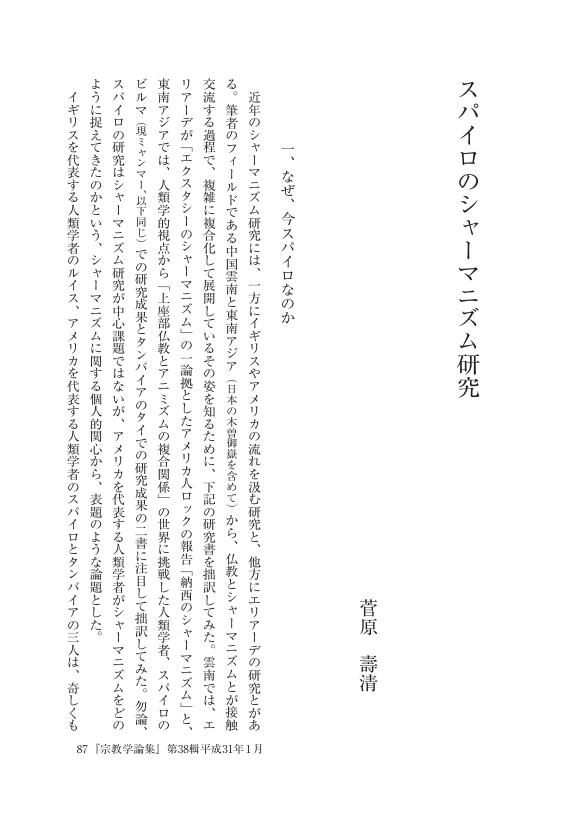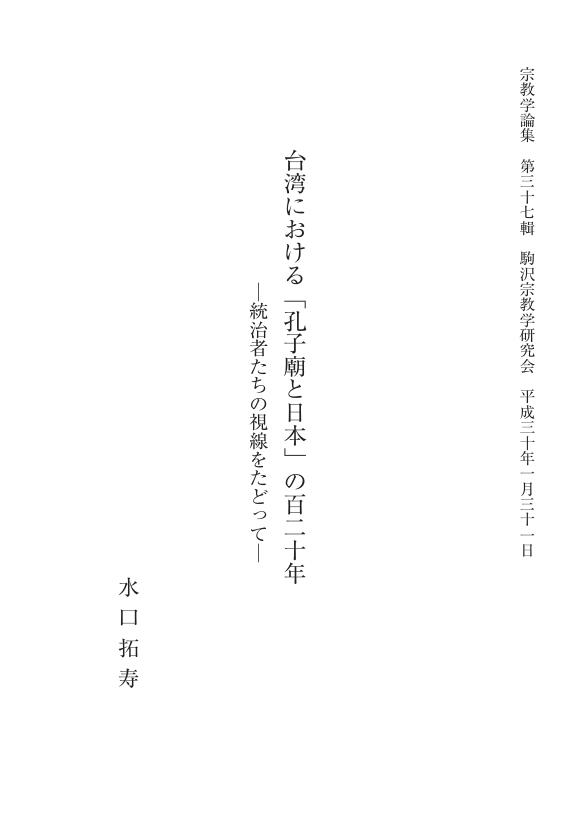8 0 0 0 OA 疫病で検出される信仰世界 近代日本のコレラ流行を中心に
- 著者
- 西村 明
- 出版者
- 駒沢宗教学研究会
- 雑誌
- 宗教学論集 (ISSN:03873323)
- 巻号頁・発行日
- vol.40, pp.53, 2021 (Released:2023-04-02)
3 0 0 0 式神の起源について
- 著者
- 鈴木 一馨
- 出版者
- 学術雑誌目次速報データベース由来
- 雑誌
- 宗教学論集 (ISSN:03873323)
- 巻号頁・発行日
- vol.20, pp.49-66, 1998
2 0 0 0 OA エリアーデのシャーマニズム研究
- 著者
- 菅原 壽清
- 出版者
- 駒沢宗教学研究会
- 雑誌
- 宗教学論集 (ISSN:03873323)
- 巻号頁・発行日
- vol.2017, no.36, pp.81-94, 2017 (Released:2021-04-17)
2 0 0 0 OA ナショナルな教会からユニバーサルな教会へ? ギリシャ正教会の特徴とグローバル化への対応
- 著者
- 内山 明子
- 出版者
- 駒沢宗教学研究会
- 雑誌
- 宗教学論集 (ISSN:03873323)
- 巻号頁・発行日
- vol.2019, no.38, pp.25-54, 2019 (Released:2021-04-17)
2 0 0 0 OA スパイロのシャーマニズム研究
- 著者
- 菅原 壽清
- 出版者
- 駒沢宗教学研究会
- 雑誌
- 宗教学論集 (ISSN:03873323)
- 巻号頁・発行日
- vol.2019, no.38, pp.87-98, 2019 (Released:2021-04-17)
2 0 0 0 日本植民地における仏教運動 : 近角常観と台湾求道会について
- 著者
- 大澤 広嗣
- 出版者
- 駒沢宗教学研究会
- 雑誌
- 宗教学論集 (ISSN:03873323)
- 巻号頁・発行日
- vol.31, pp.27-53, 2012
1 0 0 0 OA 禅宗成立における民俗仏教との関係 正法寺本『辦道話』を手がかりに
- 著者
- 渡部 正英
- 出版者
- 駒沢宗教学研究会
- 雑誌
- 宗教学論集 (ISSN:03873323)
- 巻号頁・発行日
- vol.2016, no.35, pp.113-132, 2016 (Released:2021-04-17)
The Zen sect is based on the concept “Zazen,” which means “to sit in meditation.” It is said that it was introduced from China by Doushou( 道昭) in the Nara period. While Zen's important religious mission of saving people was introduced at that time, it first became a formal sect in the Kamakura period. This was only after Dougen (道元) wrote “Bendouwa,” a book with the purpose of spreading the Zen sect. Its contents describe in detail how he introduced Zen and its message was meant to be the answer to people's questions about life. In its early manuscript, the basis of the missionary work was to continue the practice of Zazen, which involved meditations inspired by the idea of Buddha ( 仏) praying for the dead (Hotoke) for whom people wished salvation. Dougen answered the people's questions and expectations of Buddhism with Zen. He showed it mainly through the practice of sitting in contemplation. The actual activity of the Zen sect was not established until Keizan's( 瑩山) missionary work.
1 0 0 0 OA 求法のプロセスとしての宗教学 学問の自由を生きるということ
- 著者
- 田中 かの子
- 出版者
- 駒沢宗教学研究会
- 雑誌
- 宗教学論集 (ISSN:03873323)
- 巻号頁・発行日
- vol.2017, no.36, pp.97-125, 2017 (Released:2021-04-17)
1 0 0 0 OA 近世料理書から見た仏教と食 「青物」の料理から「精進料理」へ
- 著者
- 徳野 崇行
- 出版者
- 駒沢宗教学研究会
- 雑誌
- 宗教学論集 (ISSN:03873323)
- 巻号頁・発行日
- vol.2018, no.37, pp.3-26, 2018 (Released:2021-04-17)
This thesis investigates the establishment of shojin ryori by particularly focusing on vegetarian meals in cookbooks, which were published in the early modern period. In recent years, washoku and Japanese cuisine have come to occupy the spotlight. In December 2013, washoku was the twentysecond Japanese asset listed on the UNESCO’s list of intangible cultural heritages. Japanese food has also played an important role in the program— Cool Japan—adopted by the Japanese government and the country’s economic activity. Shojin ryori is a type of cuisine like that of washoku and other general Japanese cuisine. It developed under the influence of the Zen Sect, which arrived in Japan in the medieval period. However, no evidence of the term shojin ryori can be found in Buddhist texts (tenseki). Thus, it must be concluded that the term was created by people in the secular world to name Buddhist food. In other words, shojin ryori is an image of Buddhist cuisine from the point of view of the secular world. Shojin ryori began to be used by cooks in the secular world in early modern times as the commercialization of Buddhist food progressed. As a result, vegetarian meals were redefined as shojin ryori, an implicitly religious term, thanks to the word shojin. Further, analysis of the construction of the term of shojin ryori by cooks in early modern time will show that it is related to the development of the jidan system.
1 0 0 0 OA 台湾における「孔子廟と日本」の百二十年 統治者たちの視線をたどって
- 著者
- 水口 拓寿
- 出版者
- 駒沢宗教学研究会
- 雑誌
- 宗教学論集 (ISSN:03873323)
- 巻号頁・発行日
- vol.2018, no.37, pp.29-59, 2018 (Released:2021-04-17)
1 0 0 0 OA 教義解釈の力学についての一考察 戦後の大本を事例に
- 著者
- 梶 龍輔
- 出版者
- 駒沢宗教学研究会
- 雑誌
- 宗教学論集 (ISSN:03873323)
- 巻号頁・発行日
- vol.2017, no.36, pp.3-30, 2017 (Released:2021-04-17)
The purpose of this thesis is to clarify how people who belong to the Oomoto, a Japanese New religious movement, have interpreted the doctrine advocated by the religion’s founder, taking into consideration the mechanics of Japanese society and religious communities. Leaders of the Oomoto consistently desired to communicate their religious doctrine to the rest of society as well as to explain its context. While attempting to absolve myself from any kind of bias, I pay attention to the existing academic research in order to explain the nature of“ doctrine” which was invisible.
1 0 0 0 OA 白光真宏会・五井昌久の「神義論」 苦難の解釈をめぐって
- 著者
- 吉田 尚文
- 出版者
- 駒沢宗教学研究会
- 雑誌
- 宗教学論集 (ISSN:03873323)
- 巻号頁・発行日
- vol.2017, no.36, pp.31-58, 2017 (Released:2021-04-17)
This paper focuses on the concept of “theodicy” by Masahisa Goi, the founder of the new Japanese religious group Byakko Shinkokai. Although many “theodicies” have been expressed in different contexts previously, I would like to especially pick up the “theodicies” of Max Weber and Masahisa Goi. Max Weber defined his concept of“ theodicy of sufferings” as of three different types: Zoroastrian dualism, the Calvinist understanding of the hidden God, and the Indian doctrine of karma. Comparing Weber’s concept with Goi’s interpretation of hardship, a similarity between their views is seen. In brief, their idea about karma is particularly similar, though there are some differences with regard to its explanation. Goi says that suffering is a result of karma from past lives; however, this karma fades away through suffering in the present life. Goi even considered death of the flesh in a positive manner. According to his doctrine, which includes the idea of a spiritual world, the spirit that is purified through suffering will ascend to a higher spiritual world. As a result, suffering does not translate to complete despair. With this in mind, I consider the views of Masahisa Goi’s “theodicy” to be unique in his understanding of the concept.
1 0 0 0 OA 看護職をめざす学生と仏教 生命観の形成に重要な仏教思想について
- 著者
- 佐藤 達全
- 出版者
- 駒沢宗教学研究会
- 雑誌
- 宗教学論集 (ISSN:03873323)
- 巻号頁・発行日
- vol.2017, no.36, pp.61-80, 2017 (Released:2021-04-17)
1 0 0 0 OA 万国宗教会議再考 いかにして「対話」は始まるのか
- 出版者
- 駒沢宗教学研究会
- 雑誌
- 宗教学論集 (ISSN:03873323)
- 巻号頁・発行日
- vol.2014, no.33, pp.3-32, 2014 (Released:2021-05-15)
Although people have some understanding of what occurs in an inter-religious dialog, the meaning of the dialog itself is rarely made clear. This study examines what exactly is an inter-religious dialog by examining its origin in the first inter-religious dialog, the 1893 World’s Parliament of Religions, and considering why the organizer decided to conduct a “parliament.” The study provides current reasons for the examination of interreligious dialogs, followed by an outline of previous research on the reasons and meanings of inter-religious dialogs. Furthermore, the study examines how the World’s Parliament of Religions began by focusing on the organizer of the parliament. This examination of the World’s Parliament of Religions describes the organizer’s explanation of the importance of gathering the religions of the world, considering the background of the widely-held complaints and expectations against Christianity. This examination underlies a consideration of how future inter-religious dialogs may change in its aspects.
1 0 0 0 OA 近代仏教資料の整備史 儀礼研究の発展に向けて
- 著者
- 武井 謙悟
- 出版者
- 駒沢宗教学研究会
- 雑誌
- 宗教学論集 (ISSN:03873323)
- 巻号頁・発行日
- vol.2019, no.38, pp.57-83, 2019 (Released:2021-04-17)
This paper purposes to examine the relationship between the reference materials and research methods of modern Buddhism. The main subjects studied are reference tools―papers, catalogs, tables of contents, and reprints or databases―for researching Buddhist magazines. First, this study argues why it is difficult to study modern Japanese religious history and how important it is to use Buddhist magazines from the perspective of distinction and preservation of modern historical materials. Subsequently, it discusses the history of development of the aforementioned reference materials. Following the Great Kantō earthquake of 1923, since Buddhist magazines were increasingly becoming scattered and historical materials from the Meiji period were getting lost, many institutions conducted activities to preserve Buddhist magazines. In the 1930s, numerous papers and catalogs on Buddhist magazines were published. Since 1945, Ryukoku University has been continuously researching Buddhist magazines. Further, since the 1980s, a movement to publish reprints and construct databases of general newspapers has been active. After 2000, the digitization of texts on modern Buddhism, including introduction of Online Public Access Catalog (OPAC), sale of magazines converted into electronic formats, and publishing of catalogs on the web, rapidly developed. This study suggests that these reference materials enable researchers to perform efficient investigations, including keyword search, and lead to the evolution of more effective methods to study the rituals of modern Buddhism.
1 0 0 0 OA イギリスにおける自然葬の出現と普及 その社会的要件から
- 著者
- 内田 安紀
- 出版者
- 駒沢宗教学研究会
- 雑誌
- 宗教学論集 (ISSN:03873323)
- 巻号頁・発行日
- vol.2019, no.38, pp.3-23, 2019 (Released:2021-04-17)
This paper will explore the worldwide popularization of the practice of natural/green funeral by focusing on a case study of “natural burial” in the United Kingdom. Recently, some countries have provided alternative natural burial sites, for example, the United Kingdom, Germany, North America, South Korea, and Japan. Although most Western countries seem to be inspired by the United Kingdom’s practices, the unique feature of Japan’s “tree burial” practice is that its origin is not related to Western contexts. Therefore, it is important to consider how such natural options have acquired global significance among different societies. Some scholars insist that this phenomenon results from a global concern for environmental problems. For example, D. J. Davies (2005) argues that it is an outcome of environmental concerns and the decline of traditional religions in postmodern societies. However, although such discussions are important, we also have to focus on the individual context in each case to avoid simple reductionism. Accordingly, I reveal specific social contexts pertaining to the British natural burial practice. In addition, these remarks are comparable with Japanese tree burial and so that will make it clear how these different countries are in sharp contrast.
1 0 0 0 近世版本に描かれた仏壇と位牌 : 山東京伝の合巻を手がかりにして
- 著者
- 徳野 崇行
- 出版者
- 駒沢宗教学研究会
- 雑誌
- 宗教学論集 (ISSN:03873323)
- 巻号頁・発行日
- vol.34, pp.29-54, 2015
- 著者
- 池上 良正
- 出版者
- 学術雑誌目次速報データベース由来
- 雑誌
- 宗教学論集 (ISSN:03873323)
- 巻号頁・発行日
- vol.21, pp.1-24, 2002
1 0 0 0 ツァプリカのシャーマニズム研究
- 著者
- 菅原 壽清
- 出版者
- 駒沢宗教学研究会
- 雑誌
- 宗教学論集 (ISSN:03873323)
- 巻号頁・発行日
- vol.34, pp.57-68, 2015





